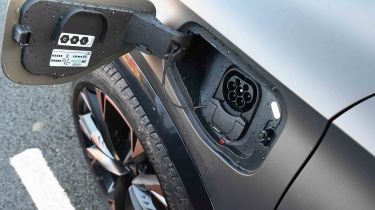Cupra Formentor - MPG, CO2 and running costs
With efficient plug-in hybrid and pure petrol models available, the Cupra Formentor doesn’t have to be expensive to run
Picking the 306bhp petrol engine will bring fairly chunky running costs; it’s a classic high-performance petrol, with four-wheel drive and an automatic gearbox, and up to 32.5mpg is the predictable outcome – although be prepared for your consumption readout to drop into the teens with fast driving. It occupies the highest 37 per cent Benefit-in-Kind (BiK) bracket because it puts out at least 192g/km of CO2, although that’s pretty similar to its main rivals, so par for the course if you’re looking at a petrol SUV with this much power.
The entry-level TSI 150 engine offers very acceptable efficiency. It returns 44.8mpg and 143g/km of CO2, which means it’ll be affordable to run for private buyers and out of the top Benefit-in-Kind (BiK) tax band for company-car drivers.
Business users will be far better off with either of the plug-in hybrids. CO2 emissions of 27-33g/km mean that BiK liability will be around a third as much as the petrol versions.
| Model | MPG | CO2 | Insurance group |
| Formentor TSI 150 | 43.5-44.8mpg | 138-142g/km | 19 |
| Formentor e-Hybrid DSG-auto 204 | 565-706.2mpg | 9-10g/km | 24 |
| Formentor e-HYBRID DSG-auto 272 | 470.8-706.2mpg | 10g/km | 26 |
| Formentor TSI DSG-auto 4Drive 333 | 30.7-32.5mpg | 198-199g/km | 33 |
Electric range, battery life and charging
Both the 201bhp and 268bhp plug-in hybrid Formentors use a 25.8kWh battery that’s a similar size to other plug-in hybrid cars from the Volkswagen group, such as the VW Passat. This gives the Cupra Formentor in e-Hybrid a range of up to 77 miles in 201bhp form or 73 miles in 286bhp guise. As a result, the Cupra Formentor e-Hybrid sits in the five per cent BiK bracket (six per cent for the 2025/2026 tax year).
Used - available now

2024 Cupra
Formentor
42,910 milesAutomaticPetrol1.4L
Cash £19,237
2024 Cupra
Formentor
26,248 milesAutomaticPetrol1.4L
Cash £20,900
2024 Cupra
Formentor
16,745 milesManualPetrol1.5L
Cash £18,800
2024 Cupra
Formentor
19,677 milesManualPetrol1.5L
Cash £20,300The maximum charging speed has increased dramatically compared with its previous iteration, from a relatively slow 3.6kW AC charging speed up to a maximum of 50kW using DC charging, enabling a 10-80 per cent top-up charge of just 26 minutes from a rapid charger. The latter is an expensive way of recharging the Formentor, so we expect most owners will utilise a typical 7.4kW home wallbox charger, which will take around four hours to fully recharge a Formentor plug-in hybrid from empty.
Tax
Every Formentor VZ model is subject to premium road tax (applied to vehicles costing over £40,000), which adds to an expensive package. For business users there’s the choice of two e-Hybrid versions - both of which sit in the five per cent Benefit-in-Kind band for 2024/25.
In order to avoid paying a premium rate of road tax, you’ll need to stick with more affordable versions using the 1.5 TSI or 1.5 eTSI engines.
Insurance groups
Insurance premiums hopefully shouldn’t be too expensive if you’re driving a Formentor - unless of course, you opt for the top-of-the-range 328bhp all-wheel-drive model which sits in group 33. The rest of the lineup occupies groups 19 to 26.
Depreciation
Choose an entry 148bhp Formentor, and you’ll benefit from the strongest residual values across the range: 47-48 per cent retained after three years and 36,000 miles. The e-Hybrid versions are a few points back on 43-45 per cent over the same period, while depreciation hits the 328bhp model hardest in VZ2 and VZ3 specifications (40-41 per cent). Go for the racy Formentor in VZ1 trim and you’ll keep around 47-48 per cent of its value.
To get an accurate valuation for a specific model, check out our valuation tool...








